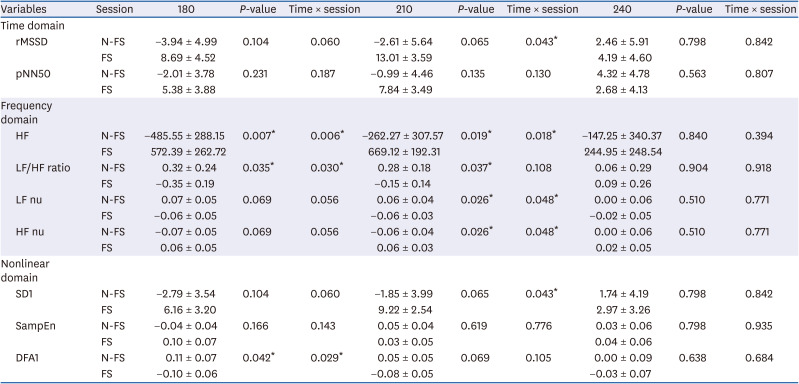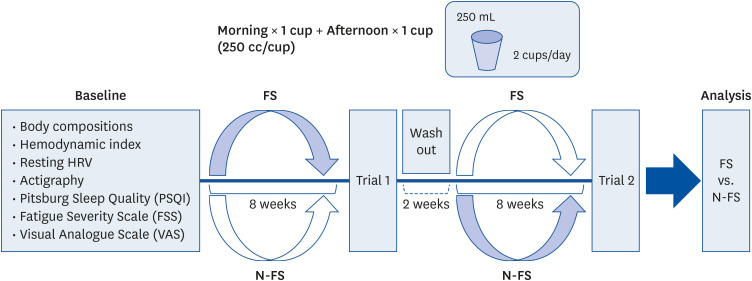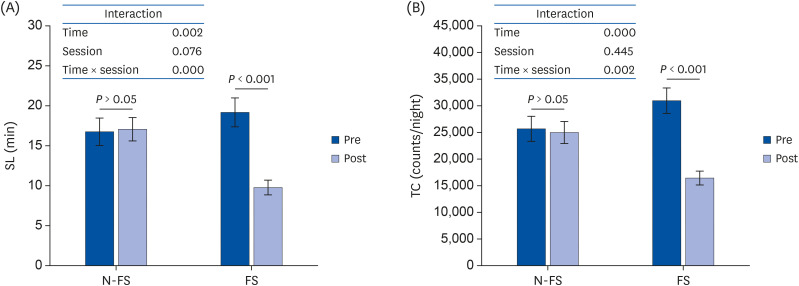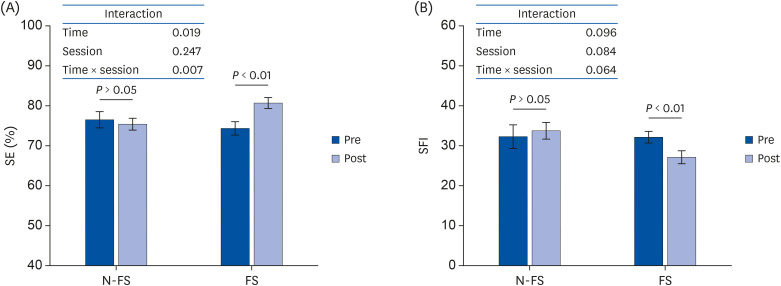1. Cirelli C, Tononi G. Is sleep essential? PLoS Biol. 2008; 6:e216. PMID:
18752355.

2. Ghorbani A, Rakhshandeh H, Sadeghnia HR. Potentiating effects of
Lactuca sativa on pentobarbital-induced sleep. Iran J Pharm Res. 2013; 12:401–406. PMID:
24250615.
3. Dodds KL, Miller CB, Kyle SD, Marshall NS, Gordon CJ. Heart rate variability in insomnia patients: a critical review of the literature. Sleep Med Rev. 2017; 33:88–100. PMID:
28187954.

4. Podsakoff PM, MacKenzie SB, Lee JY, Podsakoff NP. Common method biases in behavioral research: a critical review of the literature and recommended remedies. J Appl Psychol. 2003; 88:879–903. PMID:
14516251.

5. Pallin M, O'Hare E, Zaffaroni A, Boyle P, Fagan C, Kent B, Heneghan C, de Chazal P, McNicholas WT. Comparison of a novel non-contact biomotion sensor with wrist actigraphy in estimating sleep quality in patients with obstructive sleep apnoea. J Sleep Res. 2014; 23:475–484. PMID:
24495222.

6. Lemola S, Ledermann T, Friedman EM. Variability of sleep duration is related to subjective sleep quality and subjective well-being: an actigraphy study. PLoS One. 2013; 8:e71292. PMID:
23967186.

7. Hoevenaar-Blom MP, Spijkerman AM, Kromhout D, van den Berg JF, Verschuren WM. Sleep duration and sleep quality in relation to 12-year cardiovascular disease incidence: the MORGEN study. Sleep (Basel). 2011; 34:1487–1492.

8. Greco C, Spallone V. Obstructive sleep apnoea syndrome and diabetes. Fortuitous association or interaction? Curr Diabetes Rev. 2015; 12:129–155. PMID:
25808418.

9. Thayer JF, Lane RD. The role of vagal function in the risk for cardiovascular disease and mortality. Biol Psychol. 2007; 74:224–242. PMID:
17182165.

10. Burton AR, Rahman K, Kadota Y, Lloyd A, Vollmer-Conna U. Reduced heart rate variability predicts poor sleep quality in a case-control study of chronic fatigue syndrome. Exp Brain Res. 2010; 204:71–78. PMID:
20502886.

11. Pigeon WR, Carr M, Gorman C, Perlis ML. Effects of a tart cherry juice beverage on the sleep of older adults with insomnia: a pilot study. J Med Food. 2010; 13:579–583. PMID:
20438325.

12. Howatson G, Bell PG, Tallent J, Middleton B, McHugh MP, Ellis J. Effect of tart cherry juice (
Prunus cerasus) on melatonin levels and enhanced sleep quality. Eur J Nutr. 2012; 51:909–916. PMID:
22038497.
13. Peuhkuri K, Sihvola N, Korpela R. Diet promotes sleep duration and quality. Nutr Res. 2012; 32:309–319. PMID:
22652369.

14. American College of Sports Medicine. ACSM's Guidelines for Exercise Testing and Prescription. Philadelphia (PA): Lippincott Williams & Wilkins;2013.
15. Buysse DJ, Reynolds CF 3rd, Monk TH, Berman SR, Kupfer DJ. The Pittsburgh sleep quality index: a new instrument for psychiatric practice and research. Psychiatry Res. 1989; 28:193–213. PMID:
2748771.

16. Monk TH, Reynolds CF 3rd, Kupfer DJ, Buysse DJ, Coble PA, Hayes AJ, MacHen MA, Petrie SR, Ritenour AM. The Pittsburgh sleep diary. J Sleep Res. 1994; 3:111–120.

17. Valko PO, Bassetti CL, Bloch KE, Held U, Baumann CR. Validation of the fatigue severity scale in a Swiss cohort. Sleep. 2008; 31:1601–1607. PMID:
19014080.

18. Lee JH, Jeong HS, Lim SM, Cho HB, Ma JY, Ko E, Im JJ, Lee SH, Bae S, Lee YJ, Lyoo IK, Jeong DU. Reliability and validity of the fatigue severity scale among university student in South Korea. Korean J Biol Psychiatry. 2013; 20:6–11.
19. Kim CS, Kim MK, Jung HY, Kim MJ. Effects of exercise training intensity on cardiac autonomic regulation in habitual smokers. Ann Noninvasive Electrocardiol. 2017; 22:e12434.

20. Brosschot JF, Van Dijk E, Thayer JF. Daily worry is related to low heart rate variability during waking and the subsequent nocturnal sleep period. Int J Psychophysiol. 2007; 63:39–47. PMID:
17020787.

21. Hynynen E, Uusitalo A, Konttinen N, Rusko H. Heart rate variability during night sleep and after awakening in overtrained athletes. Med Sci Sports Exerc. 2006; 38:313–317. PMID:
16531900.

22. Heart rate variability: standards of measurement, physiological interpretation and clinical use. Task force of the European Society of Cardiology and the North American Society of Pacing and Electrophysiology. Circulation. 1996; 93:1043–1065. PMID:
8598068.
23. Kim M, Sasai H, Kojima N, Kim H. Objectively measured night-to-night sleep variations are associated with body composition in very elderly women. J Sleep Res. 2015; 24:639–647. PMID:
26250860.

24. Sadeh A. The role and validity of actigraphy in sleep medicine: an update. Sleep Med Rev. 2011; 15:259–267. PMID:
21237680.

25. Patel SR, Ayas NT, Malhotra MR, White DP, Schernhammer ES, Speizer FE, Stampfer MJ, Hu FB. A prospective study of sleep duration and mortality risk in women. Sleep. 2004; 27:440–444. PMID:
15164896.

26. Medic G, Wille M, Hemels ME. Short- and long-term health consequences of sleep disruption. Nat Sci Sleep. 2017; 9:151–161. PMID:
28579842.

27. Spiegelhalder K, Scholtes C, Riemann D. The association between insomnia and cardiovascular diseases. Nat Sci Sleep. 2010; 2:71–78. PMID:
23616699.

28. Tobaldini E, Nobili L, Strada S, Casali KR, Braghiroli A, Montano N. Heart rate variability in normal and pathological sleep. Front Physiol. 2013; 4:294. PMID:
24137133.

29. Manconi M, Ferri R, Zucconi M, Clemens S, Rundo F, Oldani A, Ferini-Strambi L. Effects of acute dopamine-agonist treatment in restless legs syndrome on heart rate variability during sleep. Sleep Med. 2011; 12:47–55. PMID:
20851046.

30. Yang PY, Ho KH, Chen HC, Chien MY. Exercise training improves sleep quality in middle-aged and older adults with sleep problems: a systematic review. J Physiother. 2012; 58:157–163. PMID:
22884182.

31. Kaminska M, Kimoff RJ, Benedetti A, Robinson A, Bar-Or A, Lapierre Y, Schwartzman K, Trojan DA. Obstructive sleep apnea is associated with fatigue in multiple sclerosis. Mult Scler. 2012; 18:1159–1169. PMID:
22183937.

32. Backhaus J, Junghanns K, Broocks A, Riemann D, Hohagen F. Test-retest reliability and validity of the Pittsburgh sleep quality index in primary insomnia. J Psychosom Res. 2002; 53:737–740. PMID:
12217446.

33. Berger AM, Kuhn BR, Farr LA, Von Essen SG, Chamberlain J, Lynch JC, Agrawal S. One-year outcomes of a behavioral therapy intervention trial on sleep quality and cancer-related fatigue. J Clin Oncol. 2009; 27:6033–6040. PMID:
19884558.

34. Cornu C, Remontet L, Noel-Baron F, Nicolas A, Feugier-Favier N, Roy P, Claustrat B, Saadatian-Elahi M, Kassaï B. A dietary supplement to improve the quality of sleep: a randomized placebo controlled trial. BMC Complement Altern Med. 2010; 10:29. PMID:
20569455.

35. Smith MT, McCrae CS, Cheung J, Martin JL, Harrod CG, Heald JL, Carden KA. Use of actigraphy for the evaluation of sleep disorders and circadian rhythm sleep-wake disorders: an American Academy of Sleep Medicine systematic review, meta-analysis, and GRADE assessment. J Clin Sleep Med. 2018; 14:1209–1230. PMID:
29991438.

36. Burkhardt S, Tan DX, Manchester LC, Hardeland R, Reiter RJ. Detection and quantification of the antioxidant melatonin in Montmorency and Balaton tart cherries (
Prunus cerasus). J Agric Food Chem. 2001; 49:4898–4902. PMID:
11600041.
37. Noorwali EA, Cade JE, Burley VJ, Hardie LJ. The relationship between sleep duration and fruit/vegetable intakes in UK adults: a cross-sectional study from the National Diet and Nutrition Survey. BMJ Open. 2018; 8:e020810.

38. Beydoun MA, Gamaldo AA, Canas JA, Beydoun HA, Shah MT, McNeely JM, Zonderman AB. Serum nutritional biomarkers and their associations with sleep among US adults in recent national surveys. PLoS One. 2014; 9:e103490. PMID:
25137304.

39. Irish LA, Kline CE, Gunn HE, Buysse DJ, Hall MH. The role of sleep hygiene in promoting public health: a review of empirical evidence. Sleep Med Rev. 2015; 22:23–36. PMID:
25454674.

40. Aristotelous P, Aphamis G, Sakkas GK, Andreou E, Pantzaris M, Kyprianou T, Hadjigeorgiou GM, Manconi M, Giannaki CD. Effects of controlled dehydration on sleep quality and quantity: a polysomnographic study in healthy young adults. J Sleep Res. 2019; 28:e12662. PMID:
29411452.









 PDF
PDF Citation
Citation Print
Print







 XML Download
XML Download